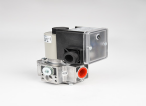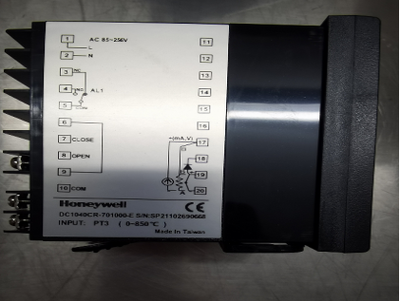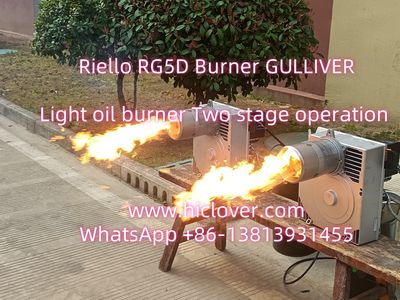Incinerator for Area health Centres
$39 000.00
Hot Sales
Price as per formly quotation. With ISO9001/CE Certification. Mobile: +86-13813931455(WhatsApp) Email:sales@hiclover.com
Incinerator for Area health Centres
Store Link: https://www.haiwos.com/ ***Product Details (***Please Sign In or Login to "My Account". Price is the EXW Factory Term price or send email to us get discount if possible and get shipping cost for delivery by CIF/C&F/FOB term: sales@hiclover.com***) WhatsApp on Mobile: +8613813931455
Brand: HICLOVER
Combustion Chamber Volume (m3): 5.00m3
Burn Rate*: Up to 225Kg per hour
Average Fuel Consumption: 30-40ltrs
www.oil-fired-incinerator.com
WA: +86-13813931455
Time to Temp: 45-60 mins
Operational Temperature: 850 - 1200°C
Gas Retention in Secondary Chamber: 2 secs
Loading Method: TOP Load
Fuel Options: Light Oil or Gas/LPG
Electricity Supply: 110v or 230v
Temperature Monitoring: Yes
Average ash residue (%): 3%
Thermostatic Device: Yes
PHYSICAL SPECIFICATIONS
External Length (mm): 6490mm
External Width (mm): 2000mm
External Height (mm): 6260mm
Door Size (mm); 4000 x 1500
Shipping Weight: 24000kg
Operating Footprint: 46.40m2
Cool Touch Cladding: Yes
|
Incinerator Items/Model |
HICLOVER TS1000(PLC) |
|
Feeding Door Location |
Top Loading |
|
Burn Rate (up to) |
225 kg/hour |
|
Control Mode |
PLC Automatic |
|
Primary Combustion Chamber |
5000L(5.0M3) |
|
Primary Combustion Chamber Internal Dimensions |
4000x1500x840mm |
|
Secondary Combustion Chamber |
2500L(2.5m3) |
|
Feed Mode |
Manual/forklift/crane ***forklift/crane supply by local |
|
Voltage |
220-240V |
|
Power |
2.0Kw |
|
Burner Type |
Italy Brand Riello |
|
Diesel Oil Consumption (Ltrs/hour) |
30-40 |
|
N.Gas/LPG Consumption (m3n/hour) |
*** |
|
Temperature Monitor |
Yes |
|
Time to Temperature |
45-60 mins |
|
Temperature Thermometer |
Corundum Probe Tube, 1400℃Rate. |
|
Temperature Protection |
Yes |
|
Automatic Cooling |
Yes |
|
Automatic False Alarm |
Yes |
|
Automatic Protection Operator(APO) |
Yes |
|
System Testing Model |
Yes |
|
Time Setting |
Yes |
|
Progress Display Bar/Timing |
LCD Display,incineration of hazardous waste |
|
Oil Tank |
200L |
|
Oil Tank Stand |
Yes |
|
Liquid level Display |
Yes |
|
Top Feeding Door |
4000x1500mm |
|
Chimney |
10Meter |
|
Chimney Type |
Stainless Steel 304 |
|
Operational Temperature |
850℃--1300℃ |
|
Average ash residue (%) |
3% |
|
Thermostatic Device |
Yes |
|
Residency Time |
2.0 Sec. |
|
Gross Weight(Average) |
24000kg(24.0Ton) |
|
External Dimensions(Main Body) |
6490x2000x6260mm |
|
1st. Chamber Composition Hot Face |
High Alumina Refractory Brick Thickness: ≥115 mm |
|
55% of Al203 |
|
|
1750°C Grade |
|
|
2nd. Chamber Composition Hot Face |
High Alumina Refractory Castable Wall Thickness: ≥150 mm |
|
60% of Al203 |
|
|
1790°C Grade |
|
|
Chamber Cold Face Material |
High Rate Refractory Ceramic Fiber 50mm |
|
Other Parts Hot Face Refractory |
Heavy Duty with steel fiber |
|
Burner operation |
Automatic On/Off |
|
Wet Scrubber |
Optional |
|
Top Loading Door |
YES |
|
Paint for outside face |
250°C Grade |
|
Sealing Material |
Refractory Ceramic Fiber |
|
CE Certificate |
CE(2006/42/EC,2014/30/EU |
|
ISO Certificate |
ISO9001:2015,medical waste incinerator cost |
Medical Waste Disposal Incinerator Risk in Kenya: Challenges and Technical Insights
Kenya’s healthcare sector faces a dual challenge: the rising volume of medical waste and the inherent risks associated with its disposal. As hospitals and clinics increasingly rely on incineration to reduce waste volume and neutralize pathogens, concerns about incinerator safety, emission standards, and environmental impacts have come to the forefront.
The Current State of Medical Waste Disposal in Kenya
In Kenya, incineration is one of the most widely adopted methods for disposing of hazardous healthcare waste. From large referral hospitals to smaller health facilities, incinerators help reduce waste volume dramatically while attempting to sanitize materials. Recent public news—such as the modern incinerator installation at a Naivasha Level IV hospital reported in mid-2023—illustrates efforts to upgrade waste management practices. However, these advancements also underline a critical point: without proper operation, maintenance, and adherence to emission standards, incinerators can pose significant public health risks.
Risks Associated with Incineration
Incomplete Combustion and Toxic Emissions
When incinerators fail to reach optimal combustion temperatures, hazardous compounds such as dioxins, furans, and heavy metals may not be fully destroyed. Studies have indicated that some facilities in Kenya operate at temperatures lower than the recommended 850˚C–1100˚C range, leading to:
- Inadequate destruction of pathogens
- Release of toxic emissions that can affect nearby communities and workers
Environmental Contamination
Poorly maintained incinerators can contribute to:
- Heavy metal accumulation in bottom ash (including copper, zinc, lead, and cadmium)
- Air pollution through the release of acid gases and particulate matter
- Soil and water contamination when hazardous residues are not managed properly
Occupational Hazards
Medical waste incinerator operators and waste handlers are at heightened risk due to:
- Exposure to toxic pollutants during waste handling and incineration
- Insufficient personal protective equipment (PPE) or inadequate training on handling hazardous emissions
Technical Insights and Optional Specifications
Modern incinerator technology offers several technical features designed to minimize risks. Understanding these features can help healthcare facilities make informed decisions and ensure safe waste management practices. Key technical options include:
- Fuel Type Options: Incinerators may run on Diesel, Natural Gas, or LPG depending on availability and cost-efficiency.
- Feeding Door Configuration: Designs include Side, Front, or Top feeding doors, each offering unique advantages for waste insertion and operator safety.
- Smoke Scrubbers: Advanced systems use Dry or Wet Scrubbers to treat flue gases and reduce toxic emissions.
- Burning Rate (Capacity): Machines are available with capacities ranging from 5kgs to 1000kgs per hour per set incinerator.
- Chamber Size: Incinerators come in various sizes—from 100 Liters up to 6000 Liters—allowing customization based on facility needs.
- System Types: Options include Containerized, Trailer, or Sledge type incinerators, providing flexibility for both fixed and mobile applications.
- Burn Material Versatility: Modern systems can handle a range of waste materials, including Medical, Animal, and Solid waste.
- Additional Features: Some units integrate PLC Automatic Control, Intelligent Sensors for continuous feeding with worker protection, adjustable High Temperature Retention (HTR), automatic cooling, and built-in Temperature Monitors (e.g., Corundum Probe Tube up to 1400℃).
- Support Components: A comprehensive incineration system also includes a range of Spare Parts and PPE to ensure uninterrupted and safe operations.
Recent Developments and Public News
Recent upgrades in Kenya’s healthcare waste management infrastructure have emphasized the importance of using modern, NEMA-compliant incinerators. For example, a modern incinerator installed at a Naivasha Level IV hospital has dramatically improved the handling of over 400 kilograms of medical waste daily while incorporating advanced flue gas cleaning systems to meet strict environmental guidelines.
Such developments are promising; however, they also serve as a reminder that even state-of-the-art incinerators require:
- Rigorous Maintenance Programs
- Regular Performance Testing
- Comprehensive Staff Training
Only by addressing these operational challenges can facilities minimize the risk of hazardous emissions and ensure public health safety.
Recommendations for Enhancing Incinerator Safety
To mitigate the risks associated with medical waste incineration in Kenya, healthcare facilities should consider the following measures:
- Implement Regular Maintenance: Schedule frequent inspections and servicing to ensure incinerators operate at optimal temperatures and meet emission standards.
- Adopt Advanced Technologies: Invest in incinerators with features such as Intelligent Sensors, PLC Automatic Control, and High Temperature Retention Systems.
- Ensure Adequate PPE and Training: Provide healthcare workers and incinerator operators with high-quality Personal Protective Equipment and regular training on safe waste handling.
- Monitor Emission Levels: Use real-time monitoring systems to detect and address any deviations in incinerator performance.
- Enhance Waste Segregation: Improve on-site waste segregation practices to prevent mixing of hazardous and non-hazardous waste, thereby reducing the load on incinerators.
- Collaborate with Regulatory Authorities: Work closely with Kenya’s National Environment Management Authority (NEMA) to ensure compliance with national and international environmental guidelines.
Conclusion
While incineration remains a critical component of Kenya’s medical waste disposal strategy, the associated risks—ranging from toxic emissions to environmental contamination—cannot be overlooked. By integrating advanced incinerator technologies, adhering to strict maintenance protocols, and prioritizing worker safety, healthcare facilities can significantly reduce these risks. Ultimately, a proactive approach in managing incinerator performance and emissions is essential to protect both public health and the environment in Kenya.
Long-tail Keywords:
Kenya medical waste disposal incinerator risk, incinerator emissions risk Kenya, healthcare waste incineration safety Kenya, advanced incinerator technology Kenya, safe medical waste disposal incinerator Kenya.
For more information on sustainable waste management solutions and advanced incinerator technology, please explore further resources from leading environmental technology providers.
DR Congo virus epidemic,Congo Kinshasa virus,250KG/HR INCINERATOR BUILDING,INCINERATOR BUILDING FLOOR PLAN ,animal carsus fertiliser 500kg per burn waste incinerator,dubai waste incinerator,waste incinerator in
United Arab Emirates
Mobile: +86-13813931455(WhatsApp)
Website: www.hiclover.com
Email: sales@hiclover.com
You May Also Like
Spare parts

DUNGS Pressure Switch GW3A6/GW10A6/GW50A6/GW150A6/GW500A6
$95.00
DUNGS Pressure Switch GW3A6/GW10A6/GW50A6/GW150A6/GW500A6
DUNGS Pressure Switch GW3A6/GW10A6/GW50A6/GW150A6/GW500A6
Spare parts

Burner 11 solenoid valve lenney MVD 205
$65.00
Burner 11 solenoid valve lenney MVD 205
Burner 11 solenoid valve lenney MVD 205
Spare parts

61 Temperature Controller Honeywell DC1040CT-701-000-E
$175.00
61 Temperature Controller Honeywell DC1040CT-701-000-E
61 Temperature Controller Honeywell DC1040CT-701-000-E
Spare parts

Riello RG5D Burner GULLIVER Light oil burner Two stage operation
$830.00
Riello RG5D Burner GULLIVER Light oil burner Two stage operation
Riello RG5D Burner GULLIVER Light oil burner Two stage operation
Schneider Servo Motor STA13/11

Schneider Servo Motor STA13/11 B0.36/8 3N23 L
$1 000.00
Schneider Servo Motor STA13/11 B0.36/8 3N23 L
Schneider Servo Motor STA13/11 B0.36/8 3N23 L
Display prices in:USD
